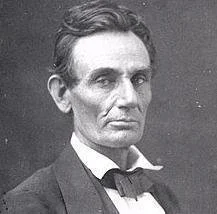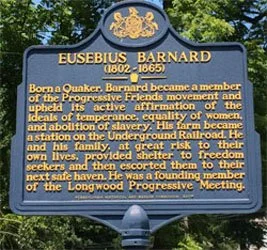Abraham Lincoln’s Quaker Roots
Traced to the Barnards of Chester County PA and Their Anti-Slavery Activism - by Loraine Lucas
Abraham Lincoln
Abraham Lincoln knew he had Quaker ancestors in Pennsylvania since his Great Grandfather John Lincoln and his Great Grand Half Uncle Abraham Lincoln married Quaker women. John Lincoln (born 1716 in New Jersey), married Quaker Rebekah Flowers (born in Chester County PA, then in 1729 that area became part of Lancaster County), they owned and sold several pieces of land in Monmouth County NJ, Lancaster County PA and Berks County PA before moving to Virginia. John’s half brother Abraham Lincoln married Quaker Anne Boone, a first cousin of Daniel Boone, and they settled near the Boone Homestead, in Amity Township, Philadelphia County which is today Exeter Township, Berks County, Pennsylvania.
Lincoln’s Great Grandmother Rebekah née Flowers Lincoln, was the granddaughter of Quakers Richard & Frances Barnard who arrived in America @ 1682 from Wiltshire, England. They were Abe’s 3rd Great Grandparents who settled in then Chester County, PA and many of their descendants spread into the area around Kennett.
Over 90 years from the Revolutionary War to the 1865 ratification of the 13th Amendment, four generations of the Barnard family in Chester County were involved in anti-slavery activism including organized anti-slavery societies, committees and the underground railroad. Often going up against others with differing perspectives on the topic, even amongst other Quakers and against federal government laws.
Richard Barnard of Newlin Township kept a diary. An entry for May 1779 read “at a conference about slaveholding”. And 10 days later an entry read “committee about slaves”. He was a model Quaker and active in Philadelphia Yearly Meeting, so the timing of this activity corresponds to the strong lobbying efforts by the Quakers and the Pennsylvania Abolition Society (America’s first abolition society) for an emancipation law. They succeeded in their efforts and the following year, 1780, The Pennsylvania Gradual Abolition of Slavery Act was passed, the first significant abolition law in the Western Hemisphere and a model for other northern states. Its goal was “to remove as much as possible the sorrows of those who have lived in undeserved bondage”. Notice the word “gradual”, it appeased slaveholders to keep the enslaved individuals they already owned unless they failed to register them annually. It did however, prohibit further importation of enslaved people and it provided for eventual freedom of individuals born of an enslaved mother.
But slavery was still legal at the federal level and the United State Congress had formulated the Fugitive Slave Act of 1793 which required the return of runaway enslaved people. Then, at the insistence of the southern slave states this Act was strengthened with the Compromise of 1850, which required even the governments and residents of free states to enforce the capture and return of runaway enslaved people. Northern Abolitionists nicknamed this the “Bloodhound Law” and this pushed many freedom seekers further north to Canada which had abolished slavery 15 years earlier in 1834. This increased risk and penalty did not deter the Barnard’s participation with the Underground Railroad and other activities.
In the 1830s abolitionists boldly joined together in numerous branches of formed Anti-Slavery Societies. The Kennett Anti-Slavery Society declared that anyone who aids in the restoration of the fugitive to his master . . . is guilty of a crime against humanity and religion and any minister of the gospel who attempted to justify slavery was to be regarded as an enemy to religion.
Many people maintained their witness against slavery by refusing to consume the products of slave labor. Free Produce Stores were established e.g. one in Hamorton which ran from 1844-1858 (today its building at RT 1 & RT 52 is current Encore Shop a quality resale shop benefitting The Chester County Hospital). Others felt that personal witness was not enough and slavery should be vigorously addressed.
Local Quaker meetings were often divided on how to respond to slavery and meetinghouses frequently became forums for anti-slavery speakers, with the talks generally held at different times of day. However, this still caused growing aggravation & criticism amongst some members. Things came to a head locally in June 1852, after Pennsylvania’s First Women's Rights Convention which was held at Horticultural Hall in West Chester (today this building is part of the Chester County History Center). The early women's rights movement and the anti-slavery movement were closely connected, so most of the local participants at the convention were also anti-slavery activists. At the conclusion of the convention it was overheard that at the invitation of William Barnard, abolitionist Oliver Johnson intended to speak at the Marlborough Friends Meeting on First Day, June 6. In anticipation of this, the conservative faction of the meeting arranged to have the local constable attend. As anticipated Oliver rose to speak and was politely asked to sit down. Pertinent to note here, he rose to speak to a religious sentiment he felt, not to speak on abolition at that moment. When Oliver rose again and persisted to speak the constable was asked to remove him but that was met with protest from many crying out “Shame!”. At the end of the meeting for worship, those who were upset that their meeting had been interrupted left and those remaining listened to Johnson present his brief testimony on anti-slavery. -- This incident was described as a Quaker Riot --. The next day, Oliver Johnson, Bartholomew Fussell, Eusebius, William & Vincent Barnard were arrested and convicted of disturbing the peace of a religious gathering. They declared that they would not pay the fine and that they were unjustly persecuted. While Dr. Fussell was speaking at his trial, a constable entered the courtroom and announced that their fines and fees had been paid, supposedly by the prosecuting party.
This encounter further escalated and the following year, fifty-eight women and men, including several Barnards, temporarily left their original meetings, many “read out” or disowned and not accepted back until many years after the Civil War ended. They created the Pennsylvania Yearly Meeting of Progressive Friends based on “moral accountability” and “practical righteousness”. They built and dedicated the Longwood Progressive Friends Meeting House in 1855 on Iand founding members Hannah & John Cox had sold to them from their property named Longwood Farm (today this is located across from the entrance gate of Longwood Gardens). Dedicated just in time for the Third Annual Session, it was opened for “religious, moral, scientific and literary” purposes and activities. It had a Quaker core but it invited participation by all who were interested in supporting various reform topics such as anti-slavery, women’s rights, capital punishment and prison reform to name a few. – A Beacon of Reform – Its annual meetings lasted for three or four days involving hundreds of people attending lectures and picnics and it's been reported as many as 500 were in attendance more than once during the anti-slavery and women's rights movement. Speakers included Frederick Douglass, Sojourner Truth, Harriet Beecher Stowe, Susan B. Anthony, William Lloyd Garrison, John J. Whittier and Lucretia Mott.
Longwood Progressive Friends Meeting
On June 20, 1862, The Longwood Progressive Friends Meeting sent a delegation of three men and three women to visit the White House: William Barnard (Abe Lincoln’s Barnard third cousin once removed, although not aware of their Quaker relationship), Thomas Garrett, Oliver Johnson, Alice Eliza Hambleton, Dinah Mendenhall and Eliza Agnew. Three Congressmen and one Senator, David Wilmot, all from Pennsylvania, introduced the delegation to President Abraham Lincoln and they presented him with a memorial (petition) urging him to end slavery. Lincoln was gracious to his visitors but he did not quickly yield to their reasoning. He noted from his Springfield speech that the American people would either agree to slavery’s “extinction,” or they would agree to its inclusion in all states. Lincoln had disappointed many abolitionists already by his placing the preservation of the Union higher than his moral objection to slavery. However, just over a month after that meeting, Lincoln shared with his cabinet the first draft of what became the Emancipation Proclamation which took effect January 1, 1863.
Could the Longwood Progressive Friends’ delegation have added some positive persuasion for one of the most important decisions in American history? William Lloyd Garrison hailed the proclamation as "a great historic event, sublime in its magnitude, momentous and beneficent in its far-reaching consequences."
Two years later, the Civil War effectively ended April 9, 1865 when General Robert E. Lee surrendered at Appomattox Courthouse. Five days later, on April 14th, President Abraham Lincoln was fatally shot and he died April 15, 1865. Later that year the United States adopted the 13th Amendment to the Constitution which abolished slavery and involuntary servitude except as punishment for a crime.
Years of effort and conviction from abolitionists like the Barnards of Chester County, along with their cousin Abraham Lincoln in Washington D.C, were of significant contribution during this historic period.
Barnard Station in Pocopson Township is a documented stop on the National Underground Railroad Network to Freedom and recently the Harriet Tubman Underground Railroad Byway, situated through Maryland and Delaware, officially enters Pennsylvania via Route 52 Kennett Pike up through Hamorton and continuing up to Barnard Station. The Friends of Barnard Station, a 501(c)(3) charitable non-profit organization, is restoring the historic Eusebius & Sarah Barnard House to the 1850s period and establishing Barnard Station Heritage Center. Check BarnardStation.org for Open House dates and “like” Barnard Station's Facebook page.



